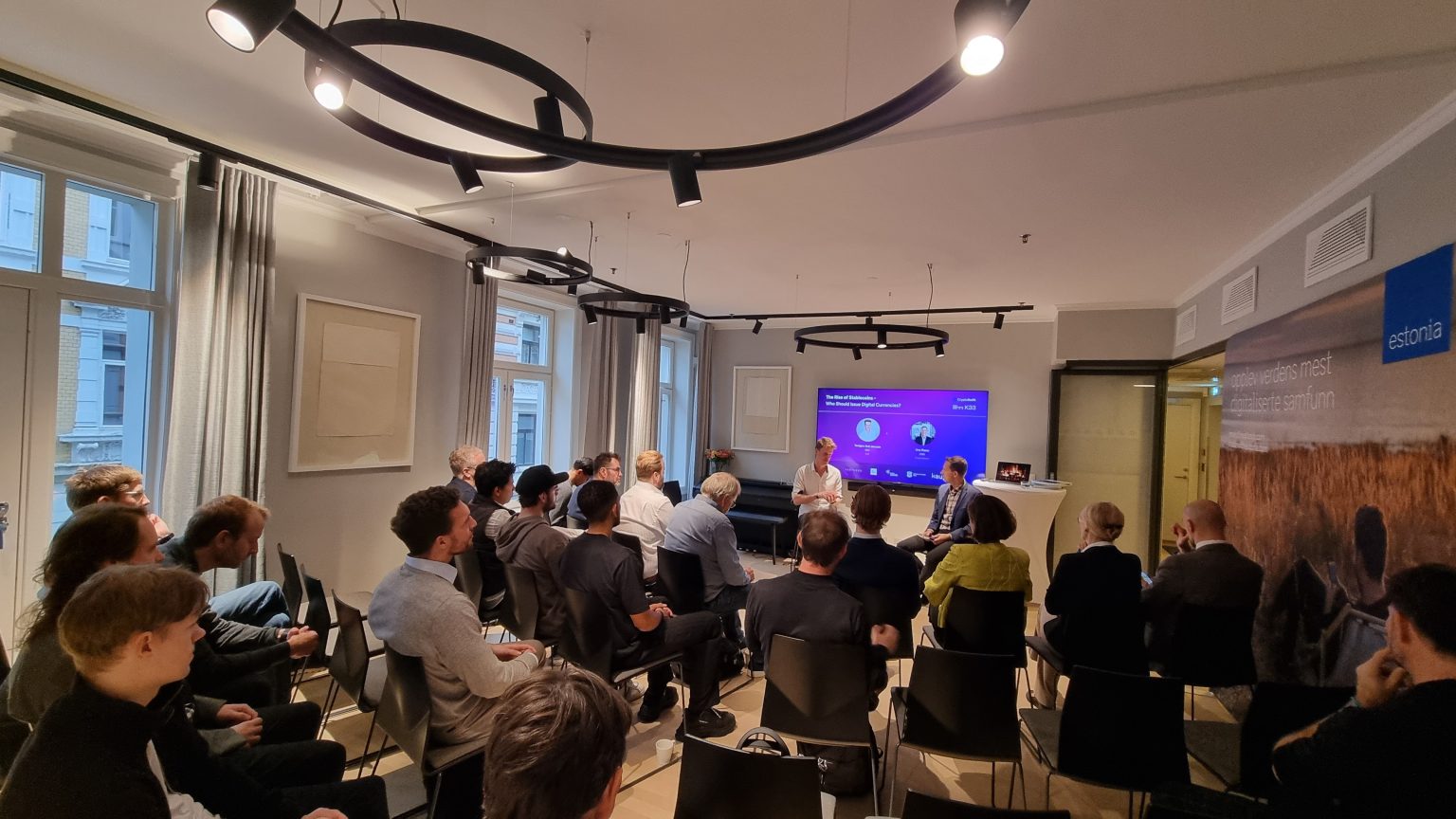A Summary of the Oslo Innovation Week Meetup at the Embassy of Estonia
On 21 October, against the backdrop of Oslo Innovation Week, CryptoSwift, K33 and the Nordic Blockchain Association gathered at the Embassy of Estonia in Oslo to dissect one of the most pressing topics in modern finance: the rise of stablecoins. The event brought together experts from Norway’s central bank, the largest commercial bank DNB, decentralized finance (DeFi) pioneers from Riften Labs, and executives from the crypto space.
The core question was simple, yet profound: Are stablecoins the killer use case for blockchain, and how should we—as societies, banks, and innovators—go about issuing, using, and governing them? The discussion unfolded in two parts: an orientational discussion on the mechanics of issuance and a high-stakes panel debate on who will ultimately control this new form of money.
Part 1: The Fireside Chat — Deconstructing the Issuer
The afternoon kicked off with a fireside chat between Torbjørn Bull Jenssen, CEO of the research-driven digital assets company K33, and moderator Uve Poom, COO of CryptoSwift. The conversation cut revolved around architectural choices behind stablecoins: who should be allowed to create them?
The discussion considered pros and cons of different issuer models. A Central Bank (CB) issuing its own digital currency (a CBDC) offers maximum security but may lack the agility for rapid innovation. Conversely, a consortium of commercial banks might seem like a stable middle ground, but history has shown them to be slow-moving and often bogged down by competing interests.
This led to the single-issuer model, which itself is split. Can a licensed financial institution (FI) innovate, or is this the domain of agile, non-bank fintechs? If so, should the issuer be centralized (like Circle’s USDC) or decentralized (like MakerDAO’s DAI)?
The dimensions for comparison are clear. Fintechs promise high innovation velocity and rapid market penetration, but they introduce significant issuer counterparty risk. If a fintech issuer fails, what happens to the peg? This is where mitigations come in. The panel explored ideas like strict capital requirements, or even “synthetic CBDCs,” where a private entity issues the coin, but all backing assets are held 1:1 in a custodial account at the central bank.
Torbjørn, however, brought the entire high-level discussion back to a single, critical point: “Some players may be positioned better or other worse to issue stablecoins, but a simple question is at the heart of the matter—what value is the user getting out of it?” If a stablecoin doesn’t offer a cheaper, faster, or more accessible service than the current system, the technical model is irrelevant.
Part 2: The Panel — “Tokenized Trust: Who Controls the Future of Money?”
The second block was a full panel titled “Tokenized Trust – Who Controls the Future of Money?” Moderated by Magnus Jones of the Nordic Blockchain Association, the panel featured a perfect cross-section of the new financial landscape:
- Peder Østbye, Director of Analysis at Norges Bank
- Lars Marius Sæverhagen, Business Developer for Tokenized Finance at DNB
- Halvor Bakke-Veiby, Co-founder of Riften Labs
Magnus Jones set the stage by noting the growing interest from major banks, referencing the recent project by a consortium of 10 global giants, including UBS, Citi, and Goldman Sachs.
The Banks’ Dilemma: When do we get on the bandwagon?
Lars Marius Sæverhagen from DNB provided a candid look inside the banking world, echoing Torbjørn’s skepticism about consortiums. He noted that while stables promise 24/7/365 settlement, banks are traditionally more concerned with profit and risk management than just speed. He also shared key takeaways from the recent Sibos financial conference in Frankfurt, where the hot topic was “tokenized bank deposits” versus stablecoins—the former being a far more comfortable, bank-controlled evolution.
The MiCA Gauntlet: Innovation vs. Regulation
The conversation inevitably turned to the EU’s landmark Markets in Crypto-Assets (MiCA) regulation. Peder Østbye of Norges Bank explained the central bank’s position: MiCA provides a much-needed regulatory framework, but their primary focus remains systemic risk. He highlighted the complexity of regulating entities like Circle, which issues its stablecoin across multiple jurisdictions, and that yield-bearing stablecoins issued by private companies can increase systemic risk as consumers will flock to private issuers who promise a return, but may well go under.
Halvor Bakke-Veiby went on to explain how their DeFi project, the decentralized stablecoin Moria by Riften Labs, had to exit the EU precisely because its innovative model isn’t covered by MiCA. This sparked the central debate of the night: Is MiCA killing innovation?
The panel largely agreed that regulation is a double-edged sword. It brings legitimacy and security (which DNB and Norges Bank require) but can stifle the very innovation that makes DeFi compelling. This was highlighted by MiCA’s restriction on paying yield for stablecoins, a stark contrast to the US.
Geopolitics and the Future of Money
The panel then zoomed out to the geopolitical landscape. Today, 99% of stablecoin value is pegged to the US dollar. How do issuers like Tether make $13 billion in profit? By holding massive amounts of US T-bills. This creates an enormous, non-bank demand for US government debt.
Will MiCA help the Euro stablecoin market catch up? The panel was skeptical. The dollar’s dominance is a powerful network effect. In the end, the question “Who controls the future of money?” had no single answer.
The consensus was a future of parallel systems. One, a government-controlled, regulated, and bank-driven system (tokenized deposits, synthetic CBDCs) offering safety and legitimacy. The other, a permissionless, high-risk, high-reward DeFi ecosystem growing larger and more innovative at the edges.
In sum: the stablecoin revolution is not a distant concept. From shipping companies paying crews in USDC to projects in Africa using USDT for solar-powered charging stations, the “digital and physical infrastructure” is already melting together. Financial history is in the making.

